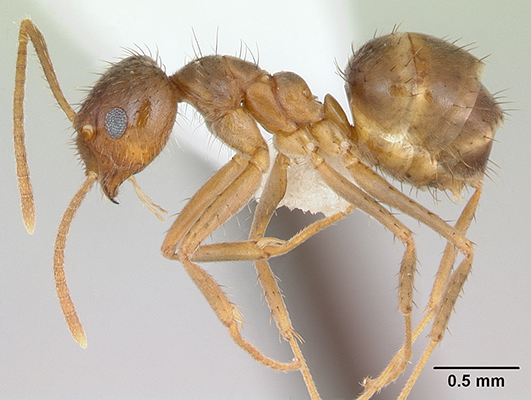
PHOTO: April Nobile / Image Copyright © AntWeb 2002 – 2023. Licensing: Creative Commons Attribution License
Formerly categorized as N. pubens, tawny crazy ants (TCA) were discovered in Houston, Texas, in 2002 by pest management professional Tom Rasberry, ACE, which led to it being known as the “Rasberry crazy ant” until its current common name took hold in recent years as a better descriptor of its coloring. Per the U.S. Department of Agriculture’s bulletin on the species: “Nylanderia fulva is an invasive ant that has been reported in Florida, Texas, Louisiana and Mississippi. It has been called the Caribbean, brown, hairy, and Rasberry [sic] crazy ant, but it now is known officially as the tawny crazy ant (TCA). This invasive ant can develop extremely large populations that can overrun agricultural, natural, and urban landscapes. These ants damage crops, reduce biodiversity and property values, and are a severe nuisance to homeowners and businesses.”
The online bulletin from Texas A&M instructs readers to “suspect tawny ants if you see a lot of ants with the following characteristics”:
- Appearance of many (millions) of uniformly-sized 1/8 inch long, reddish-brown ants in the landscape; foraging occurs indoors from outdoor nests.
(Click to see video of these ants found in the grass.) - Under a microscope you will find 12-segmented antennae, a petiole (1 node), an acidopore (circle of hairs at the tip of the gaster (abdomen), and the ant will be covered with many hairs (macrosetae).
- Winged males… are needed for identification to species (see Gotzek et al. 2012)
- Ants that form loose foraging trails as well as forage randomly (non-trailing) and crawl rapidly and erratically (hence the description “crazy” ant).
- Ant colonies (where queens with brood including whitish larvae and pupae…) occur under landscape objects like rocks, timbers, piles of debris, etc. These ants do not build centralized nests, beds, or mounds, and do not emerge to the surface from nests through central openings.
“In infested areas, large numbers of tawny crazy ants have caused great annoyance to residents and businesses,” the Texas A&M Bulletin continues. “In some situations, it has become uncomfortable for residents to enjoy time in their yards. Companion animals may, in some cases, avoid the outdoors as well, and wildlife such as nesting songbirds, can be affected. The cumulative economic impact is currently unknown… In place of a stinger, worker ants possess an acidopore on the end of the gaster (abdomen), which can excrete chemicals for defense or attack. They are capable of biting, and when bitten, they cause a minute pain that quickly fades.
“In areas infested by the tawny crazy ant, large numbers of ants have accumulated in electrical equipment, causing short circuits and clogging switching mechanisms resulting in equipment failure (see ‘Ants and Their Affinity for Electrical Utilities’ at http://www.extension.org/pages/30057/ants-and-their-affinity-for-electrical-utilities)… At the foundation of any [integrated pest management, or] IPM strategy are cultural control methods beginning with the removal of harborage such as fallen limbs, rocks, leaf litter, and just about anything sitting on the ground that isn’t absolutely necessary. Cultural methods can also include altering the moisture conditions in a landscape. Crazy ants prefer humid, wet conditions so reducing the amount of irrigation, repairing leaks, and improving drainage should help.”
REFERENCES
- USDA-ARS Publication #294671, accessed 2/21/23: ARS.usda.gov/research/publications/publication/?seqNo115=294671
- Texas A&M University fact sheet, accessed 2/21/23: UrbanEntomology.tamu.edu/urban-pests/ants/rasberry
Leave A Comment